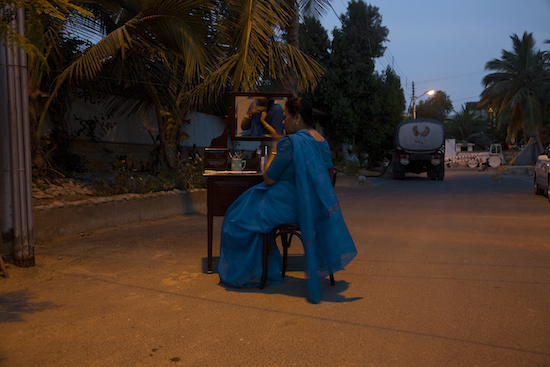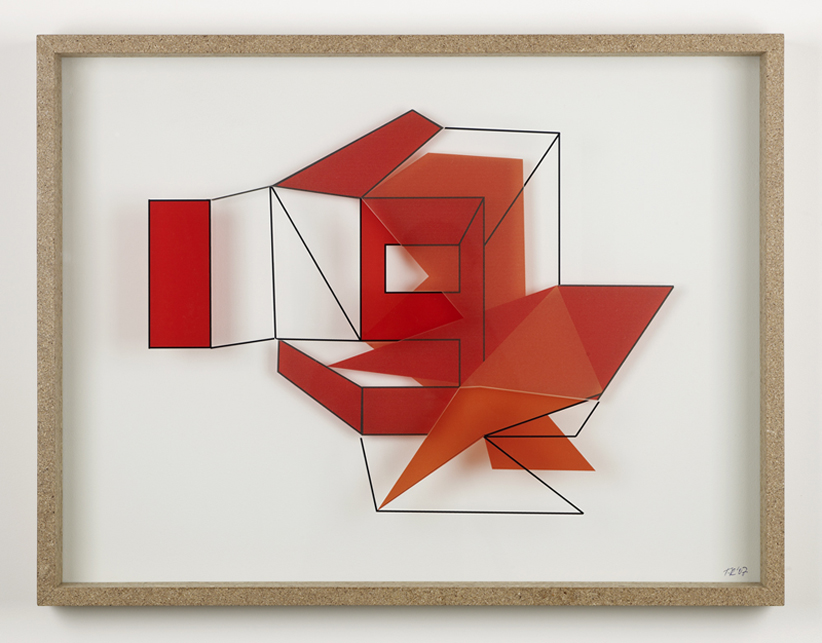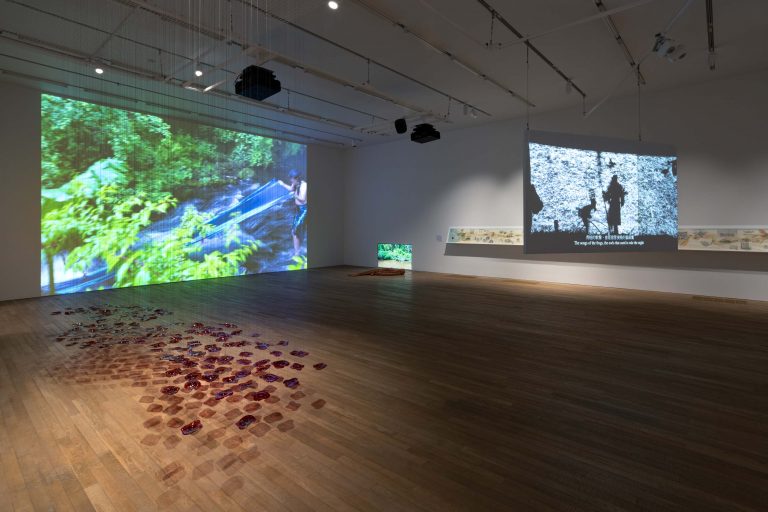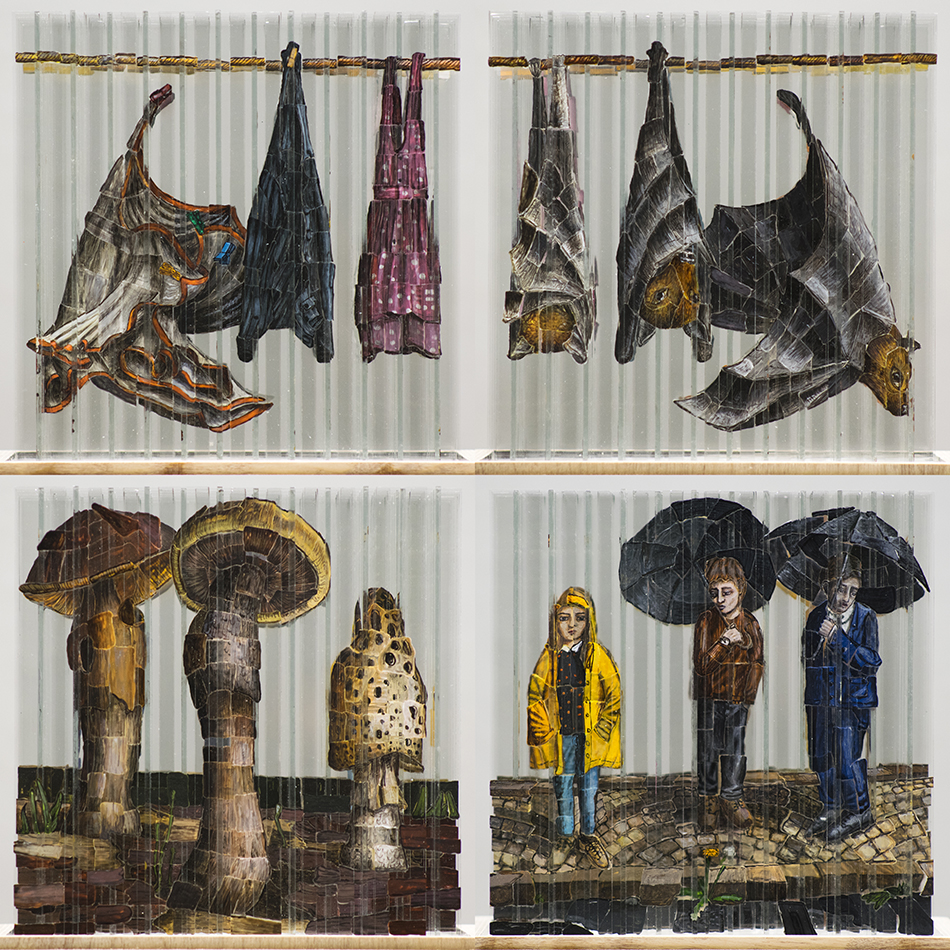Death at a 30 Degree Angle
2012 - Film & Video (Film & Video)
14:59 minutes
Bani Abidi
The perceived effortlessness of power, projecting above experiences of labored subordination is examined in Death at a 30 Degree Angle by Bani Abidi, which funnels this projection of image through the studio of Ram Sutar, renowned in India for his monumental statues of political figures, generally from the post-independence generation. In a contemporary Indian society beholden by strongmen, Abidi uses Sutar’s studio to fictionalize a sculptor producing commemorative works for populist, preening figures, surrounded by the likenesses of idolized politicians of the post-colony. Abidi’s video presents one such aspirational bureaucrat, trailed by a cadre of lackeys who fawn over the varying statues that are laboriously carted out for his approval. Never satisfied with his depiction, he works his way through a variety of increasingly ridiculous poses, the work a biting critique of the infallible facade produced through monumental imaging. Using the active mechanisms which concretize the reification of political figures, Death at a 30 Degree Angle intimately dissects the nationalist construction of political identity in India, to reveal the labor and profound inanity that lies beneath. All the while, scattered prototypes of Gandhi take in the bluster of the politician and the chaotic action of the shop assistants, invoking Gandhi’s own humanist reputation and famous image as aspirational. A complex doubling specter emerges over the actions of the politician, registering larger questions about India’s increasingly populist turn in juxtaposition with the lionization of early figures in the independent nation, which was notably marred by ethnic violence. Set in an uncertain state of action, Death at a 30 Degree Angle paints a scathing, cautious picture of the visual rhetoric of contemporary Indian politics. Death at a 30 Degree Angle mobilizes the searingly critical direct address that motivates portions of Abidi’s work. In its fictionalized account that dramatizes a disturbingly probable event, it radiates uncertainty about the efficacy and direction of apparatuses of power and control in India. Focused on an overtly political resonance, Death at a 30 Degree Angle highlights the emphasis on transformative, critical approaches to potentiality that her work has recently employed to grapple with politics, inequalities, and cultural differences in South Asia.
Bani Abidi’s practice deals heavily with political and cultural relations between India and Pakistan; she has a personal interest in this, as she lives and works in both New Delhi and Karachi. The artist’s subject matter ranges from border tensions to immigration conflicts, cultural diversity, and the relationship between private and public space. She works in the media of video, photography, and drawing.
Colors:
Related works featuring themes of: » Artist as Ethnographer, » Collective History, » Conflict, » Cross-Cultural Dialogue
» see more

© » KADIST
Simon Starling
2007Invited in 2007 to the Museum Folkwang in Essen (Germany), Simon Starling questioned its history: known for its collections and particularly for its early engagement in favor of modern art (including the acquisition and exhibition of works by Cézanne, Gauguin, Van Gogh, Matisse), then destroyed during the Second World War, the museum was pillaged for its masterpieces of ‘degenerate art’ by the nazis...

© » KADIST
Mariana Castillo Deball
2015Taking archaeology as her departure point to examine the trajectories of replicated and displaced objects, “Who will measure the space, who will tell me the time?” was produced in Oaxaca for her exhibition of the same title at the Contemporary Museum of Oaxaca (MACO) in 2015...

© » KADIST
Claudia Joskowicz
2007The primary interest in the trilogy is Joskowicz’s use of cinematic space, with long tracking shots that portray resistance to habitual viewing experiences of film and television...

© » KADIST
Xiaoyun Chen
2014The central point of Vanishing Point is the most direct physiological reaction of the body to the environment...
Other related works, blended automatically
» see more

© » KADIST
Bani Abidi
2008The threshold in contemporary Pakistan between the security of private life and the increasingly violent and unpredictable public sphere is represented in Abidi’s 2009 series Karachi ...

© » KADIST
Simon Starling
2007Invited in 2007 to the Museum Folkwang in Essen (Germany), Simon Starling questioned its history: known for its collections and particularly for its early engagement in favor of modern art (including the acquisition and exhibition of works by Cézanne, Gauguin, Van Gogh, Matisse), then destroyed during the Second World War, the museum was pillaged for its masterpieces of ‘degenerate art’ by the nazis...

© » KADIST
Mariana Castillo Deball
2015Taking archaeology as her departure point to examine the trajectories of replicated and displaced objects, “Who will measure the space, who will tell me the time?” was produced in Oaxaca for her exhibition of the same title at the Contemporary Museum of Oaxaca (MACO) in 2015...

© » KADIST
Xiaoyun Chen
2012The lengthy titles in Chen Xiaoyun’s work often appear as colophons to his photographs that invite the viewer to a process of self realization through contemplating the distance between word and image...
Related works sharing similar palette
» see more

© » KADIST
Subas Tamang
2018Study of History III by Subas Tamang is an etching and aquatint print based on photographs taken by German photographer Volkmar Wentzel in 1949...

© » KADIST
Kristen Morgin
2008Jeep Comics is based on the second of only two issues published by RB Leffingwell and Company in 1944–45...
Other works by: » Bani Abidi
» see more

© » KADIST
Bani Abidi
2008The threshold in contemporary Pakistan between the security of private life and the increasingly violent and unpredictable public sphere is represented in Abidi’s 2009 series Karachi ...

© » KADIST
Bani Abidi
2008The threshold in contemporary Pakistan between the security of private life and the increasingly violent and unpredictable public sphere is represented in Abidi’s 2009 series Karachi ...
Related artist(s) to: Bani Abidi » Shilpa Gupta, » Adel Abdessemed, » Adrian Paci, » Dan Perjovschi, » Dora Garcia, » Eko Nugroho, » Hou Hanru, » Oliver Ressler, » Pedro Reyes, » San Francisco
» see more

© » KADIST
Dora Garcia
2012KLAU MICH is a TV and performance project by Dora García with Ellen Blumenstein, Samir Kandil, Jan Mech, TheaterChaosium, and Offener Kanal Kassel, during the 100 days of dOCUMENTA (13)....

© » KADIST
Eko Nugroho
2009Nugroho’s installations and performances have their roots in the shadow puppet rituals in Indonesia, particularly the Javanese Wayang tradition whose essence is in the representation of the shadows...

© » KADIST
Shilpa Gupta
2014These hand drawn maps are part of an ongoing series begun in 2008 in which Gupta asks ordinary people to sketch outlines of their home countries by memory...
Related works found in the same semantic group
» see more

© » KADIST
Manuel Correa
2020Manuel Correa’s short film Didn’t Know I Died is a testimonial portrait of the acclaimed Colombian poet Olga Elena Mattei...

© » KADIST
Tobias Rehberger
20079’oclock (my time is not your time) pertains to a series consisting of three numbers: 5, 10 and 11 works were made for the exhibition “Signs and messages from modern life” at the Kate McGarry Gallery in 2007...





